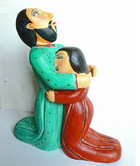Marie Romero Cash
Artists do not often receive the recognition they deserve from the Christian community, so, I was glad to attend a worship service at the St. Francis Basilica in Santa Fe, New Mexico, in July 2009, honoring santeros (saint-makers) of the American South West, who were taking part in the annual Spanish Colonial Market in the nearby Plaza. Accompanied by the music of pipe organ and mariachi band, the sacred folk-art makers filed into the Cathedral behind a feather-decked cross, displaying bultos sculptures, retablos painted panels, colcha embroidery, hammered tin crosses, and other samples of their work to be blessed by Roman Catholic Archbishop Michael Sheehan. He thanked them all for “feeding us with your art,” reminding the folk artists to "keep religion at your fingertips."
As the procession passed by, I spotted Marie Romero Cash, carrying a little sculpted Sacred Heart of Jesus. In a craft, traditionally, dominated by men, this santera holds the singular distinction of being chosen in 1997 to paint the Stations of the Cross panels, now, hanging in the Basilica’s side aisles. Growing up in the 1950s in a conservative Hispanic family, where the rosary was recited every day before a home altar, Cash moved away from Santa Fe and her Catholic upbringing, only to find faith, again, and a new artistic vocation, when she returned home in the 1970s. In her autobiography, Tortilla Chronicles, Cash writes: “I have come full circle, embracing Catholicism and gaining a new devotion to the Holy Spirit. It has been a journey to return and participate in my religion. These days, I rarely begin the day without a short prayer asking that my work be infused with God’s spirit.”
Cash comes from a “dynasty” of saint-makers and artisans. Her father, Emilio, and mother, Senaida, helped revive traditional hammered-tin art with pieces they crafted at their kitchen table and were honored at the White House. Seven members of her family circle are artists, working as sculptors, tinsmiths, retablo painters, and colcha stitchers, including her son, Gregory Lomayesva. Mother and son took part in a 2001 Santa Fe show titled Common Bonds, Uncommon Art, where Marie’s santero-styled works were juxtaposed with Gregory’s modernist, mixed media creations, incorporating painted and silk-screened religious imagery. Cash believes that “without family there is no culture, no faith, no soul,” and she has done much to foster the rich cultural heritage of her extended Hispanic “family” not only through her art but also as the author of short stories, memoirs, albums on home altars and santos (saint-paintings), and a guide to the village churches of Northern New Mexico.
Cash’s artwork remains true to the canons of santero art, but she constantly pushes the boundaries outward by introducing new saints and non-traditional subjects. Her sculpted pieces are much prized by folk art collectors and competition for her new works at the Spanish Colonial Market is intense. Buyers write their names on a sign-up sheet beside her display table before the selling officially begins, and her best works are usually gone within minutes of the market’s opening. As a first time visitor, I watched the frenzied buying with amazement, not really expecting to find anything left, when I looked over Cash’s table later in the day. To my surprise, an unusual reliquary-like box, painted on both sides and lids with the Stations of the Cross, was still there. I asked Cash how this beautiful piece had been overlooked. She replied: “You were meant to have it.” And she was right!
My collection of sacred artworks by this highly versatile New Mexican santera has grown since then to include another "reliquary" box, depicting the Four Evangelists and Christ, decorated on the sides with vignettes from the life and Passion of Jesus and on the end panels with images of Christ, the Lamb of God, and Christ, enthroned in glory. A painting of St. Francis and a Crucifix are set in the kind of hammered tin frames for which the Romero family is famous. Three other crosses in my collection show the Tree of Life, decorated with angels, birds, flowers, and the sun and moon; the Adoration of the Angels, where the dying Jesus is surrounded by 27 angels, interlocked in a beautiful lacework pattern; and the Four Evangelists, inspired by a medieval European crucifix.
Cash is known for her free-standing sculptures, known as bultos, and created figure studies of the Good Shepherd , Pieta, and The Return of the Prodigal Son especially for the Sacred Art Pilgrim Collection. She often pushes the boundaries of the saint-making tradition in whimsical works like her giant panel, An Alphabet of Saints. Saint Andrew, for "A," leads off this visual divine dictionary on the lower left. Saint Zita, for "Z," sits on the top row flanked by the Angels Michael and Raphael and surmounted by the Holy Trinity. Cash has even found someone for "X," Saint Xantippa, a virgin martyr of Spain!
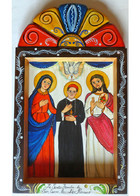
St. Oscar Romero
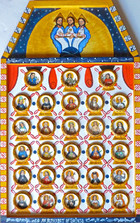
An Alphabet of Saints

The Childhood of Christ Altarpiece
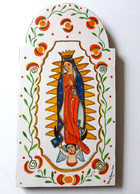
The Virgin of Guadalupe

St. Francis in Contemplation
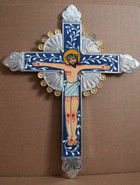
Crucifix
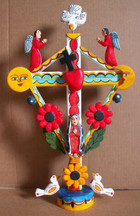
The Tree of Life Cross
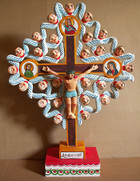
The Adoration of the Angels Cross
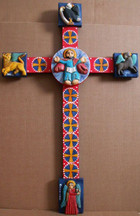
The Four Evangelists Cross
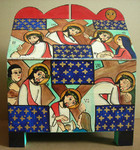
Stations of the Cross Box
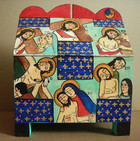
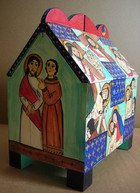
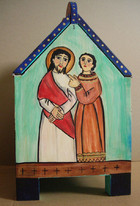
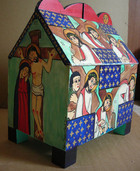
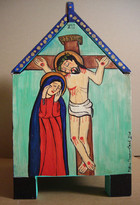
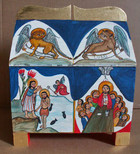
The Four Evangelists and Christ Box

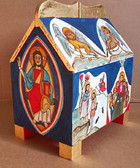
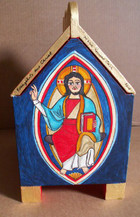
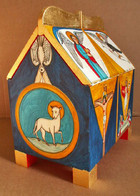
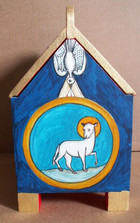
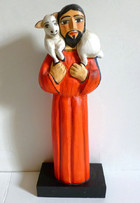
The Good Shepherd
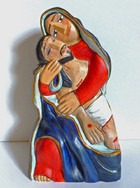
Pieta
